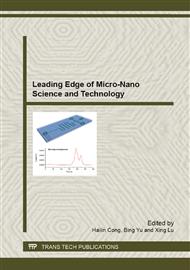[1]
D. Larcher, M.R. Palacin, G.G. Ammtucci, et al. Electrochemically active LiCoO2 and LiNiO2 made by cationic exchange under hydrothermal conditions, J. Electrochem Soc., 144 (2): 408-417 (1997).
DOI: 10.1149/1.1837424
Google Scholar
[2]
G. X. Wang, J. Horvat, D. H. Bradhurst, et al. Structural, physical and electrochemical characterization of LiNixCo1-xO2 solid solutions, J. Power Sources, 85: 279-283 (2000).
DOI: 10.1016/s0378-7753(99)00349-3
Google Scholar
[3]
T. Kelley, E. Mitchell, Lithium manganese oxide-based active material, USP: 6322744, (2001).
Google Scholar
[4]
N. Yabuuchi, T. Ohzuku, Novel lithium insertion material of LiNi1/3Co1/3Mn1/3O2 for advanced lithium-ion batteries, J. Power Sources, 119-121: 171-174(2003).
DOI: 10.1016/s0378-7753(03)00173-3
Google Scholar
[5]
M.H. Lee, Y.J. Kang, S.T. Myung, et a1. Synthetic optimization of Li[Ni1/3Co1/3Mn1/3]O2 via co-precipitation, Electrochimica Acta, 50: 939-948 (2004).
DOI: 10.1016/j.electacta.2004.07.038
Google Scholar
[6]
Tong Dong-gea, Lai Qiong-yu, Wei Ni-ni, Synthesis of LiNi1/3Co1/3Mn1/3O2 as a cathode material for lithium-ion battery by water-in-oil emulsion method, Materials Chemistry and Physics, 94: 423-428 (2005).
DOI: 10.1016/j.matchemphys.2005.05.025
Google Scholar
[7]
M. Kageyama, D.C. Li, K. Kobayakawa, et a1. Structural and electrochemical properties of LiNi1/3Co1/3Mn1/3O2-xFx prepared by solid state reaction, J. Power Sources, 1(157): 494-500 (2006).
DOI: 10.1016/j.jpowsour.2005.08.002
Google Scholar
[8]
P.Y. Liao, J. G. Duh, S.R. Sheu, Structural and thermal properties of LiNi0. 6-xMgxCo0. 25Mn0. l5O2 cathode materials,J. Power Sources, 183: 766-770 (2008).
DOI: 10.1016/j.jpowsour.2008.05.058
Google Scholar
[9]
K.S. Park, M.H. Cho, S.J. Jin, K.S. Nahm, Electrochem Solid-State Lett 7: A239–A241(2004).
Google Scholar
[10]
Y.M. Choi, S.I. Pyun, S.I. Moon, Effects of cation mixing on the electrochemical lithium intercalation reaction into porous Li1- δNi1-y CoyO2 electrodes, Solid State Ionics, 89(1/2): 43-52 (1996).
DOI: 10.1016/0167-2738(96)00269-x
Google Scholar
[11]
J .N. Reimers, E. Rossen, C.D. Jones, J.R. Dahn, Solid State Ionics, 61: 335–344 (1993).
Google Scholar


